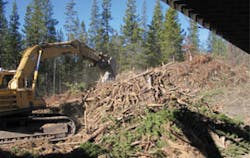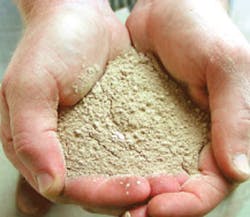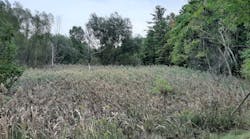Revegetating an area is rarely achieved with seed alone. Climate, soil conditions, budget, and project deadlines are just a few considerations that contractors must initially make regarding mulch and soil amendment choice as they work to make the most of the seed they’ve selected. A requirement to use, native seed can sometimes complicate these decisions, but native seed is usually the best choice for long-term protection.
Mixing seeds and their enhancing and protecting partners can and should be approached as a science. Finding the right balance between quick groundcover and long-term protection means placing your faith in strong, proven performers as well as the willingness to try innovative methods that can save your project time and money. Learning which choices are the right ones for your site can take periods of trial and error. Several professionals recently shared their experience with seed, mulch, and soil amendment use in the field.
Protecting Wildlife Habitat in Wyoming
Sage-grouse populations have been declining in Johnson County, WY, as well as across the state as a whole for the past century. The state is undergoing a process determining whether the bird species should be listed as endangered, says Colleen Faber, a senior reclamation and regulatory analyst at Lance Oil & Gas Company, which is a subsidiary of Anadarko Petroleum Corporation, based in Gillette, WY.
Close-up view of the first year growth of falcate and native grass and forb species at the Wyoming site
“We look for opportunities like our seeding and reclamation to enhance their habitat while also developing energy resources for our nation,” she says, citing as an example a site in Johnson County, which included seeding a pipeline right of way. “Our seeding was very successful and established very well within two years, and it used species sage grouse and other wildlife and livestock species utilize.”
A seed mix that included western wheat, green needle, slender, thickspike, purple prairie clover, maple grove native flax, yellow prairie coneflower, western yarrow, and falcate alfalfa was added to the loamy-to-clay loamy soil at the site. It was planted at a rate of just over 15 pounds of pure live seed per acre.
Seed choice had been determined by federal requirements. “The federal lands in this project required only native seed-indigenous to the area, not collected from the area,” says Faber. “We included falcata alfalfa on our private lands to enhance the habitat for sage grouse. This project area has one of the largest sage grouse populations in northeast Wyoming, along with mule deer and pronghorn populations.”
Faber described the area’s topography as challenging. “We are working with very “˜breaky’ country where the soils can change in very short distances,” she says.
Workers broadcast-seeded the yarrow, explains Faber, while “the remaining species were drill seeded with a drag behind the seeder.”
Although Lance Oil & Gas didn’t use mycorrhizal fungi or fertilizers on this project, it has used them on others.
Logs, woody shrubs, and small trees are ground into mulch and used onsite.
Faber explains that on the project’s steeper slopes, the company used Lehi, UT-based Granite Seed Company’s hydromulch to enhance seed establishment as well as to provide erosion control. Granite also provided the seed for the project.
“We chose Granite Seed because of the quality and cleanness of the seed they provide,” says Faber. She adds that although cheat grass (downy brome) had infested the native rangeland at the project site, “our right of ways show native species establishing and outcompeting these invasive annuals and stabilizing our soils, while also enhancing the native range land.”
Adding Fungi for Performance and a New Type of Mulch for Protection
Tourist areas thrive on aesthetics, and this emphasis carries into their regional roadwork. When an area needs to be revegetated following construction, groundcover, which is on display, must be achieved inexpensively and must be built to handle difficult situations on a long-term basis.
In the fall of 2006, a highway located west of Sunriver, OR, was being reconstructed, connecting Highway 97 to the Mount Bachelor ski resort. The Sunriver to Mt. Bachelor Highway Project took place on a road that is heavily used by members of a recreational community.
“The road was already in, but it needed realignment to make it safer,” explains David Steinfeld, a soil scientist with the USDA Forest Service. He works with the Western Federal Lands Highway Division, which administers road projects adjacent to or located on federal lands. “When roads are realigned, they often create new road cuts and fills, which need to be restored.”
Squirreltail, Idaho fescue, mountain brome, common woolly sunflower, antelope bitterbrush, lodgepole pine, and ponderosa pine seeds were locally collected and used at the site. Native seeds were used, following federal guidelines.
“We use native plants unless there is a reason not to, and there was no reason not to,” says Steinfeld, who served as the project manager for the revegetation of native plants at this site. “We collected genetic material that was local to the site. You might find something that’s five miles away, but this is seed that was collected specifically for the project.
“The grass and forb seeds were collected in that area and sent to our farmers, who increased the seed. The other species were already in our local seed stores.”
A variety of seed mixes were used at several areas of the site.
“We used the tree seed at the high elevations on very tough sites where we wanted trees but couldn’t plant them,” says Steinfeld. “We used the bitterbrush seed at lower elevations. There were two grass seed mixes: low and high elevation. Rates depended on the site and species mix.”
Seeds often need encouragement to flourish. Mycorrhizal fungi were added to the seed mixes.
“The spores from the fungi begin to attach and affect the root system. It’s a relationship that began millions of years ago. We use mycorrhizal fungi when working to restore highly disturbed sites, especially if topsoils are gone and we are working only with subsoils,” says Steinfeld. “We assume that there will be no inoculum of mycorrhizal fungi to establish on plant roots. Since mycorrhizae is essential for establishing most of the species we work with, we have to apply it in a powder form to our seeds before we sow.”
Fungi from Mycorrhizal Applications, based in Grants Pass, OR, were purchased for use at the site.
Mycorrhizal fungi added to seed mixes
“Mycorrhizae also helps restore soils by excreting organic glues called glomalin, which are important for creating and maintaining soil structure,” explains Steinfeld. “It is important to understand that we integrate mycorrhizal fungi into an overall strategy of trying to create conditions for a functioning soil to develop over time.”
Other strategies he describes include using tillage in an effort to improve soil structure; adding organic mulch, slash, and composts; improving soil nutrition through the use of fertilizers and composts; and increasing slope and soil stability.
The site’s soils are typically deep, with a sandy, loamy texture. “The soils are derived from a pumice parent material originating from Mount Mazama about 6,850 years ago, so they are quite young,” Steinfeld says. “In their natural state, they have low bulk densities with nutrient levels that are in the lower ranges for most plants.”
During the first year, the project was hand-seeded. After seed germination, workers applied fertilizer after the rainy season.
Workers applied a slow-release organic fertilizer (Biosol) at the site during the second year at a rate of approximately 1,500 to 2,000 pounds per acre.
“The second year, we applied fertilizer with the seed,” says Steinfeld, noting that at this time mulch was applied over the soil to improve germination and for surface stabilization. “Because the climate is semi-arid, the soil surface dries out quickly in the spring, just when the seeds need to have moisture to germinate. Without mulch, seeds dry out quickly and die. You have to have a protection for it not to dry out for at least the next 10 to 20 days. It’s got to be stable, and it’s got to be protected. We applied about 0.8 inch of wood fiber mulch on the entire project, which amounted to about 100 to 120 cubic yards per acre.”
During the second year, the site was hydroseeded.
Steinfeld had seen the giant piles of slash that came from the road right-of-way material, and he decided to have mulch created from this pile of trees, shrubs, and organic material using a large grinder. When roads are realigned or created, he explains, soil becomes exposed that must be vegetated. Instead of burning the organic material that’s removed to make way for the new vegetation, Steinfeld sought to create an organic mulch to protect the seeds.
“The challenge was that this was the first time we made mulch out of right-of-way material,” he says, adding the material was high in carbon. “We were trying to figure out the mulch rates and application rates.”
The mulch was blown over about 20 acres of the site.
“The take of the vegetation was good. I am so impressed with it, because it really does slow down sediment,” says Steinfeld. “Then, on top of it, you get the seed mulch. It’s a little more expensive, but you’re not in there trying to fix things year later.”
Steinfeld explains that his organization is working to return carbon “into highly efficient soils,” adding that this process can take time.
“It doesn’t create a soil instantly,” he says. But at this site, reusing organic material already present turned a green solution into a successful one.
Properly Nurturing Natives
Crystal Creek Prairie Park in Mokena, IL, is the site of a large-scale wetland mitigation with an approximately 14-acre upland prairie buffer, according to Tony St. Aubin, operations officer of the Crete, IL, office of JFNew, a native seed grower and installer that also designed the project for local resident use.
“The park includes paved walking trails, signs, benches, and trash receptacles,” he explains.
The vegetation that was so crucial to the site’s survival provides a home for an assortment of wildlife. “The site offers a great grassland and wetland birding habitat and has seen state-listed birds,” he notes.
Careful thought was given to seed choice for the project. Approximately 10 to 15 native species were added to several seed mixes used on the site, including an upland prairie mix, a mesic prairie mix, a wetland edge mix, and shallow emergent seed mixes, says St. Aubin.
JFNew used a variety of seed instillation techniques with the clay-loam soil.
“The seed was installed using a Truax drop seeder and stabilized using the Hydrostraw StrawNet pellets,” says St. Aubin, adding that drill seeding was also used. The area received a Plateau herbicide treatment to discourage unwanted plant growth, and clay pellets were added to benefit the shallow emergent mix. “The pellets were applied via broadcast application using a Cyclone broadcaster.”
Various aspects of individual areas of the site determined the customized instillation approach that JFNew took, says St. Aubin. “Each installation technique has unique benefits and was used based on site-specific details such as existing vegetation regime, hydrology, and anticipated erosion potential.”
The topsoil had been stripped before excavation began on the wetlands but was later replenished. The seedbed was tilled and raked before any seeds were sown. Because the replenished topsoil was suitable for the project, says St. Aubin, the company didn’t add soil amendments.
“Although no soil amendments were used during this project, JFNew did use a cover crop with the permanent matrix seed mix to help alleviate weed pressure from undesirable species,” he says. “The upland areas had significant issues with nondesirable species such as teasel, crown vetch, and Canadian thistle.”
The company decided to take on this challenge with a long-term approach.
“A multi-year management plan, which includes prescribed burning, selective herbicide application, mowing, and reseeding, has significantly decreased weed pressure and increased native species diversity and density.
“The wetland areas had significant variations in hydrology levels, and JFNew has experienced everything from severe drought to severe rains. Included in the original design was a water control structure, Agri Drain, which has allowed us to help manipulate hydrology and hence increase survival/persistence of native species.”
Because it was a large wetland mitigation project, a native buffer was required at the site, says St. Aubin. While some projects need fast-establishing vegetation to protect the soil from erosion, it is not a consideration on many sites where native plants are a requirement. For some people, there is even a question as to how local a seed species must be to an area before it can be considered a native species of that site. St. Aubin explains how localized the seed was at the Crystal Creek site: “Genotyping of seed has become a hot topic among the restoration community over the past several years. Since this project was to design and implement during 1999 through 2002, genotyping of seed was not a controversial topic,” he says. “JFNew supplied species native to Will County, but they may not have been propagated from local plants.”
Looking for Long-Term Growth In a Short Growing Season
Choosing the right soil amendments can be crucial when working at high altitudes. Seed can dry out quickly here, as well as be assailed by strong winds. The Berthoud Pass widening, a Colorado Department of Transportation project near Berthoud Falls, CO, in 2000, is an example of one such project.
“The main challenge on the project was the altitude: 10,500 feet and up to the summit,” says Ron Dean, an estimator with Down To Earth Compliance based in Denver, of the effort to widen US Highway 40. “The growing season was extremely short. The average date of last frost is June 30 and average first frost is July 30. It was not uncommon to have snow and rain showers every afternoon with severe lightning storms.”
Seed for the project-a blend of native species of grass and forbs including western wheat, slender wheat, Canby bluegrass, sideoats, blue grama, lupine, showy goldeneye, and Ponderosa pine-was added at “50 pounds plus an acre,” according to Dean. It had to be propagated at a similar altitude to the Berthoud Pass in Rocky Mountain states to be approved for use at the highway site, he explains. Slopes were steep, and the soil was extremely rocky. Biosol organic fertilizer from Bowman Construction based in Denver was used to stimulate vegetative growth.
“Biosol was applied at 2,000 pounds per acre, humate at 1,000 pounds per acre, and superphosphate at 100 pounds per acre,” says Dean. “The areas were hydromulched with a ton of wood fiber and 200 pounds of tackifier. The amendments were to establish a sustainable soil condition for the grass and forbs.”
The organic fertilizer is designed to provide nutrients for plants throughout their growth cycle, improving a soil’s humus content, controlling thatch, promoting microbes, and stimulating root development. Biosol, he explains, was selected because it’s been used on most CDOT projects for years and the organization is familiar with its benefits.
“Biosol was chosen because of the success establishing grasses in the Rocky Mountain region,” says Dean.
The altitude wasn’t the only challenge that the workers at the site experienced. Highway construction typically can create a treacherous job site, a site where workers cannot afford to lose focus.
“Traffic control was very difficult, which made seeding and mulching an adventure,” says Dean. “The tourists did not understand that the mist from spraying hydromulch with tack was difficult to remove from their cars, so the occasional green car was seen limping down the pass to the car wash.”
Respecting Runway Restrictions
The expansion of O’Hare International Airport in Chicago-the second busiest airport in the world, according to a recent Airports International Council report-is both a massive and a delicate project. Countryside Industries of Wauconda, IL, has 14 different contracts totaling more than $2 million at the worksite, seeding thousands of acres during the next few years. Lee Keenan, a vice president with Countryside Industries, explains the difficulties of establishing and protecting seeded areas at one of the recently installed airport runways.
“Any work you’re going to do at an airport, you’re going to have challenges. There are restricted-access areas, timing when we could have access to it, getting people properly badged,” says Keenan, adding that the company balanced security issues as well.
A tall fescue seed mix was selected for the site, he says, particularly because it establishes itself quickly and won’t attract birds, which can cause problems at airports. Applying sod wasn’t an option, primarily because of the cost of water to initially maintain it.
“We seeded with brilliant seeder, and then we used a 13:25:12 slow-release fertilizer,” says Keenan. The seeding took place July 2008 into August 2008. One concern that workers had was that the runway needed to “go live” during the last days of September.
Workers applied roughly an acre of North American Green’s HydraCX2 to the site, which has helped the vegetation establish itself. The product is composed of straw, polymers, and reclaimed cotton plant material that is combined and then hydraulically applied.
“The HydraCX2 allows stabilization on the runway without using blankets and staples, which are not allowed near a live runway of an airport,” says Keenan.
The vegetation will create a green appearance that holds an appeal for the millions of travelers who will pass through the terminal, as well as prevent the erosion that can occur at airport construction sites, bringing together beauty and functionality.





